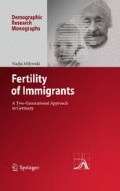Abstract
In this chapter we discuss the results in the context of the theories and our working hypotheses on the impact of international migration on fertility. Some reflections are then offered on the work presented here. The study concludes with perspectives for further research. The analyses of the transitions to the three parities have shown the importance of distinguishing between immigrant generations when we study the fertility behavior of immigrants from Turkey, the former Yugoslavia, Greece, Italy, and Spain in West Germany. First-generation immigrants are more likely to have a first, second, and third child than are West Germans, whereas women of the second generation have the higher transition rates only for the first (and the third child without significance). The differences in fertility risks between first- and second-generation immigrants are significant for the transitions to a first and second child, but not for the third child.
Access this chapter
Tax calculation will be finalised at checkout
Purchases are for personal use only
Notes
- 1.
Straßburger (2003) has shown, for example, that second-generation migrants of Turkish descent in Germany see their union as constituting a link between the two families.
- 2.
If compared to the first-generation immigrants who gave birth before they moved to West Germany, immigrants coming without a child are on average about two years older at entry into motherhood. This may indicate that migration postpones childbearing, however, such a comparison is not reasonable since it conditions the emigrants on the later move, and we do not have information on all women in the countries of origin, either.
- 3.
The recruitment of highly qualified IT specialists from non-EU countries has been an exception since 2000.
- 4.
This has also been shown for women and men of Turkish descent in The Netherlands (de Valk 2006).
- 5.
Kelek (2006) has pointed out that “the” strong Turkish family coincides with a high degree of social control, as well as a lack of individualization and self-responsibility. Early marriage is seen as desirable mainly for women. Parents may not invest in the (higher) education of their daughters when they assume that the daughter will marry at age 16.
References
Andersson, G., and K. Scott. 2005. Labour-market status and first-time parenthood: The experience of immigrant women in Sweden, 1981–97, Population Studies 59(1): 21–38.
Angenendt, S. 2002. Einwanderungspolitik und Einwanderungsgesetzgebung in Deutschland 2000–2001, in K. J. Bade and R. Münz (Hgs.), Migrationsreport 2002. Fakten – Analysen – Perspektiven. Frankfurt, New York: Campus Verlag, pp. 31–59.
Bade, K. J. 1994. Ausländer, Aussiedler, Asyl in der Bundesrepublik Deutschland. 3. Aufl. Hannover: Niedersächsische Landeszentrale für politische Bildung.
Baizan, P., A. Aassve, and F. C. Billari. 2003. Cohabitation, Marriage, and First Birth: The Interrelationship of Family Formation Events in Spain, European Journal of Population 19(2): 147–169.
Carlson, E. 1985b. Increased nonmarital births among foreign women in Germany, Sociology and Social Research 70(1): 110–111.
Delgado Perez, M., and M. Livi-Bacci. 1992. Fertility in Italy and Spain: The Lowest in the World, Family Planning Perspectives 24(4): 162–167+171.
De Valk, H. 2006. Pathways into adulthood. A comparative study on family life transitions among migrant and Dutch youth. Utrecht: Thela Thesis [Doctoral Thesis].
Diehl, C. 2002b. Wer wird Deutsche/r und warum? Bestimmungsfaktoren der Einbürgerung türkisch- und italienischstämmiger junger Erwachsener – Ergebnisse des Integrationssurveys des BiB, Zeitschrift für Bevölkerungswissenschaft 27(3): 285–312.
Fleischer, A. 2007. Familienbildungsprozesse als Möglichkeit der Legalisierung: Zur Situation Kameruner MigrantInnen in Deutschland. WP-2007-011. Rostock: MPIDR. www.demogr.mpg.de/papers/working/wp-2007-011.pdf.
Frank, R., and P. Heuveline. 2005. A cross-over in Mexican and Mexican-American fertility rates: Evidence and explanations for an emerging paradox, Demographic Research 12(4): 77–104. www.demographic-research.org/Volumes/Vol12/4/.
Friedman, D., M. Hechter, and S. Kanazawa. 1994. The theory of the value of children, Demography 31: 375–401.
Fritzsche, Y. 2000. Die quantitative Studie: Stichprobenstruktur und Feldarbeit, in A. Fischer, Y. Fritzsche, W. Fuchs-Heinritz, and R. Münchmeier (Hgs.), 13. Shell Jugendstudie, Bd. 1/Quantitative Studie. Opladen: Leske+Budrich, pp. 349–378.
Kane, T. T. 1989. Streams of Change: Fertility, Nuptiality, and Assimilation of Guestworker Populations in the Federal Republic of Germany. Garland Studies in Historical Demography. New York, London: Garland Publishing [Doctoral Thesis].
Kelek, N. 2006. Die muslimische Frau in der Moderne, Aus Politik und Zeitgeschichte 1–2: 25–31.
Kreyenfeld, M. 2001a: Employment and Fertility. East Germany in the 1990s. Rostock: University of Rostock [Doctoral Thesis].
Kreyenfeld, M. 2002. Time Squeeze, Partner Effect or Self-Selection?: An Investigation into the Positive Effect of Women’s Education on Second Birth Risks in West Germany, Demographic Research 7(2): 15–48. www.demographic-research.org/Volumes/Vol7/2/.
Milewski, N. 2007. First child of immigrant workers and their descendants in West Germany: Interrelation of events, disruption, or adaptation?, Demographic Research 17(29): 859–896. www.demographic-research.org/Volumes/Vol17/29/.
Münscher, A. 1979. Ausländische Familien in der Bundesrepublik Deutschland – Familiennachzug und generatives Verhalten. München: DJI Verlag.
Nahmias, P. 2004. Fertility behavior of recent immigrants to Israel: A comparative analysis of immigrants from Ethiopia and the former Soviet Union, Demographic Research 10(4): 83–120. www.demographic-research.org/Volumes/Vol10/4/.
Portes, A., and M. Zhou. 1993. The New Second Generation: Segmented Assimilation and Its Variants, Annals of the American Academy of Political and Social Science 530 (Interminority Affairs in the U.S.: Pluralism at the Crossroads): 74–96.
Roloff, J. 1998. Eheschließungen und Ehescheidungen von und mit Ausländern in Deutschland, Zeitschrift für Bevölkerungswissenschaft 23(3): 319–334.
Schwarz, K. 1996. Die Kinderzahl der Ausländer und ihre Bedeutung für die Bevölkerungsentwicklung in den alten Bundesländern, Zeitschrift für Bevölkerungswissenschaft 21(1): 57–67.
Sørensen, A. 2007. Introduction to the special issue: Family change among immigrants. Examples from Germany and Sweden, Zeitschrift für Familienforschung 19(1): 5–9.
Straßburger, G. 2003. Heiratsverhalten und Partnerwahl im Einwanderungskontext. Eheschließungen der zweiten Migrantengeneration türkischer Herkunft. Würzburg: Ergon Verlag [Doctoral Thesis].
Yavuz, S. 2008. Fertility Decline in Turkey from the 1980s Onwards: Patterns by Main Language Groups. Ankara: HUIPS [Doctoral Thesis].
Rights and permissions
Copyright information
© 2010 Springer-Verlag Berlin Heidelberg
About this chapter
Cite this chapter
(2010). Discussion. In: Fertility of Immigrants. Demographic Research Monographs. Springer, Berlin, Heidelberg. https://doi.org/10.1007/978-3-642-03705-4_4
Download citation
DOI: https://doi.org/10.1007/978-3-642-03705-4_4
Publisher Name: Springer, Berlin, Heidelberg
Print ISBN: 978-3-642-03704-7
Online ISBN: 978-3-642-03705-4
eBook Packages: Humanities, Social Sciences and LawSocial Sciences (R0)

